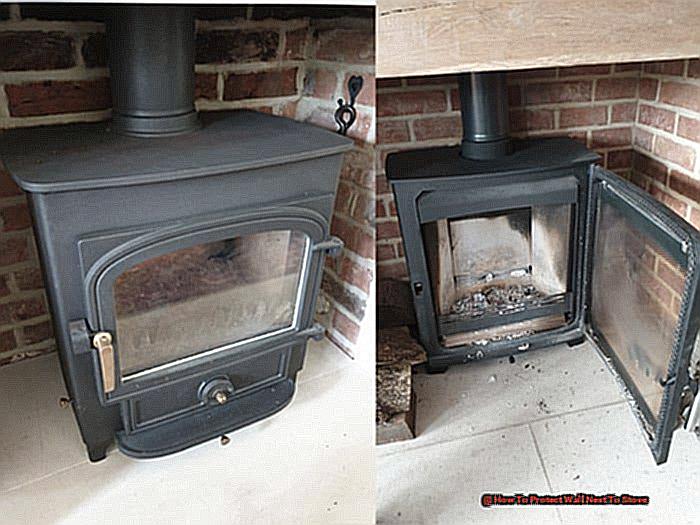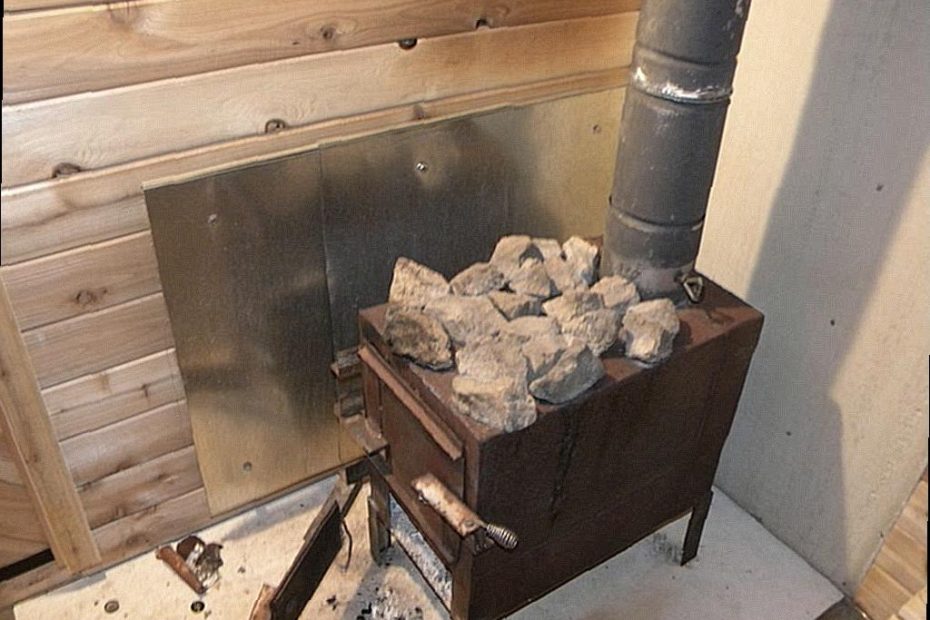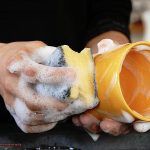Are you tired of the never-ending battle against stains and splatters on the wall next to your stove? Are you constantly scrubbing and repainting, only to have the same problem arise again and again? You’re not alone. Many homeowners struggle with keeping their kitchen walls clean and protected, especially in the area surrounding their stoves.
But fear not, because we have some expert tips on how to protect your walls near stoves and maintain a pristine kitchen. With just a few simple steps, you can save yourself time and money on endless cleaning or repainting. So let’s dive in and learn how to keep that wall spotless.
Here are some key points to remember:
- Install a backsplash: A backsplash serves as a protective barrier between your stove and the wall. There are various options available such as tile, stainless steel, or even peel-and-stick designs.
- Consider heat-resistant paint: If installing a backsplash isn’t an option for you, consider using heat-resistant paint on the wall next to your stove. This will prevent any damage from high temperatures.
- Act quickly with spills: As soon as something spills or splatters on the wall, don’t wait. Clean it up immediately to prevent any stains from setting in.
- Use a splatter screen: When cooking with oil or sauces, use a splatter screen to shield your walls from any messy accidents.
By following these tips, you can effectively protect your kitchen walls and ensure they stay looking fresh for years to come. Say goodbye to constant scrubbing and hello to a beautiful kitchen.
Contents
Clearances, Precautionary Measures, and Regulations
The recommended distance for a wall adjacent to a stove is 18 inches, according to the National Fire Protection Association (NFPA). This separation is crucial in mitigating fire hazards, as it guarantees that no flammable materials are in direct contact with the stove’s heat source. However, this gap may vary depending on the type of stove used; therefore, it’s essential to consult the manufacturer for their specific recommendations.
To provide additional protection for the wall next to a stove, there are various precautionary measures that can be implemented. These include installing a heat-resistant material like a stainless steel sheet or tiled backsplash, using a heat shield, keeping combustible materials away from the stove, and regularly cleaning and maintaining the appliance. These actions can greatly reduce the risk of fire hazards and safeguard the wall from heat damage.
It’s also vital to be aware of any regulations that may govern stove clearances and safety measures. Each state may have its own building codes and regulations, so it’s important to seek advice from local authorities or a professional contractor before making any modifications or installations near the stove.
Adhering to the recommended clearances and implementing precautionary measures can effectively protect a wall next to a stove.
Concept of the Heat Shield
The concept of a heat shield is to create a protective barrier between a heat source, like a stove, and the adjacent walls. This is particularly crucial in the kitchen, where stoves can generate intense levels of heat and pose a potential fire hazard to nearby walls.
The primary purpose of a heat shield is to safeguard the wall next to a stove from direct heat and flames that may arise during cooking. This is achieved by reducing the recommended 18-inch clearance between the stove and the wall to a lower distance of approximately 6 inches.

But how exactly does a heat shield protect the wall? The answer lies in its material composition. Heat shields are typically crafted from non-combustible materials, such as metal, ceramic, or glass. These materials are able to withstand high temperatures without igniting or melting, unlike traditional wall materials like drywall or wood.
When correctly installed, the heat shield acts as a buffer between the stove and the wall, effectively preventing any direct contact between the two. This not only shields the wall from potential damage but also minimizes the risk of fire. Furthermore, a heat shield can also help disperse and redirect heat away from the wall, further mitigating any potential harm.
There are various types of heat shields available on the market, including prefabricated options or DIY solutions. Prefabricated shields often come with installation instructions and may require specific attachments or hardware. DIY solutions involve cutting a piece of scrap wood to 6 inches in length and attaching it to the wall using heat-resistant materials.
So, a heat shield serves an essential function in protecting the wall next to a stove from intense temperatures and potential fire hazards.
Clearance of Stovepipes
As per the standards set by the National Fire Protection Association (NFPA), the recommended distance for clearance between a stovepipe and the wall is 6 inches. This safety measure is necessary to prevent potential fire hazards while cooking and to avoid any damage to the wall.
When installing a stovepipe, it is imperative to adhere to these clearance guidelines in order to ensure adequate ventilation and minimize the risk of fire. Under no circumstances should a stovepipe come into direct contact with a wall or any other combustible materials. This is where a heat shield comes into play.
A heat shield is a protective barrier made of non-combustible materials that reduces the recommended 18-inch clearance between a stove and wall to just 6 inches. It acts as a barrier between the stovepipe and the wall, effectively preventing direct contact and potential fire hazards while cooking.
In addition, it is important to note that the horizontal section of an uninsulated stovepipe should not be longer than three-quarters of the section of the flue above where they connect. This is essential for proper ventilation and to prevent any buildup of smoke or dangerous gases.
To better understand the recommended clearances for different types of stoves, refer to the following table:
| Stove Type | Clearance from Wall | Recommended Heat Shield |
| Wood Stove | 36 inches | Yes |
| Pellet Stove | 12 inches | No |
| Gas Stove | 6 inches | No |
| Electric Stove | 2 inches | No |
| Oil Stove | 18 inches | No |
It is important to keep in mind that these clearance requirements may vary depending on the manufacturer’s instructions and local building codes. It is always advisable to consult with a professional or refer to the specific stove’s manual for accurate clearance guidelines.
Wood Burning Stove Wall Protection Ideas
There are numerous effective techniques for safeguarding the walls adjacent to a wood-burning stove from heat and smoke damage. These include implementing a stove wall protector, installing backsplash tiles, thoughtfully positioning the stove, and taking into account the material of the wall itself.
Stove Wall Protector:
A specific type of protection designed to deflect heat away from the wall, reducing the risk of damage. It can be easily set up and removed as needed, making it a convenient option for wood-burning stove owners. This is a suitable solution for both short-term and long-term protection.
Backsplash Tiles:
Backsplash tiles are another popular choice for shielding walls near wood-burning stoves. They are resistant to heat-related harm and can cover the entire kitchen wall, providing long-term protection for the inner foundation of the wall. However, it is crucial to consider the upfront investment required for proper installation of backsplash tiles.
Proper Placement of Stove:
One straightforward way to prevent damage to the walls is by correctly positioning the stove. This entails ensuring that it does not come into contact with any walls or only has one side touching, as this can reduce heat exposure to the surrounding walls. It is essential to consult with a professional or refer to the stove’s manual for accurate guidelines on clearance requirements.
Consider Wall Material:
Drywall is typically fire-resistant and can withstand exposure to heat from a wood-burning stove. However, additional protection such as backsplash tiles may be necessary depending on the type and intensity of heat emitted from the stove.
In conclusion, utilizing a stove wall protector or installing backsplash tiles are both effective methods for safeguarding walls near wood-burning stoves.
Conclusion
In conclusion, safeguarding the wall next to your stove can be a daunting task for homeowners. The constant scrubbing and repainting can quickly become frustrating and costly. But fear not, with expert tips and precautions, you can save yourself time and money while maintaining a pristine kitchen.
One effective way to protect your wall is by installing a backsplash or using heat-resistant paint. These options create a protective barrier between your stove and the wall, preventing any damage from heat or spills. Acting quickly with spills and utilizing a splatter screen can also prevent stains from setting in.
It’s crucial to be aware of clearances, precautionary measures, and regulations when it comes to protecting your kitchen walls. A heat shield is an essential tool that reduces the recommended clearance distance between a stovepipe and the wall from 18 inches to just 6 inches. By acting as a buffer, it prevents direct contact and potential fire hazards.
For wood-burning stoves, there are various options such as stove wall protectors or backsplash tiles that offer long-term protection against heat damage. Proper placement of the stove and considering the material of the wall are also important factors to keep in mind.
By implementing these tips and techniques, you can effectively safeguard your kitchen walls from stains, splatters, and potential fire hazards while maintaining a beautiful space for years to come.





